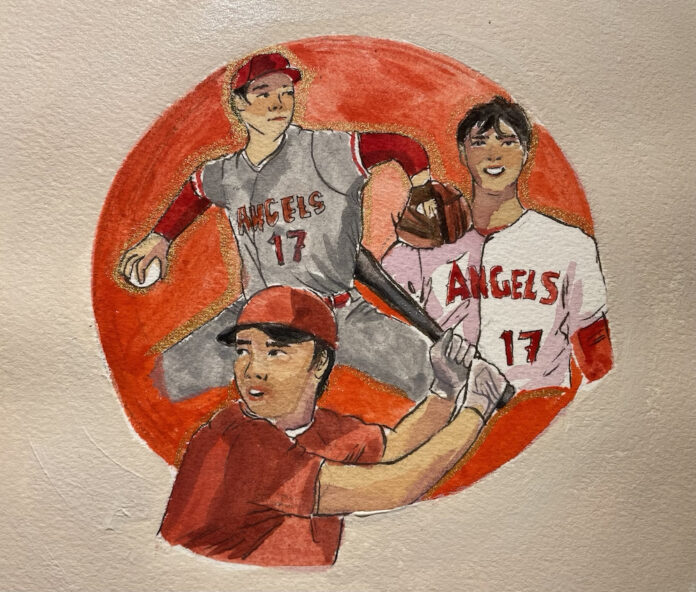There is a real-life superhero among us, folks. An hour-long Uber from Oxy will take you to his lair, where he hurls lasers at 100 mph, hits moonshots as far as 463 feet and can run 29.5 feet per second.
If you haven’t guessed it, the lasers are pitches, the moonshots are home runs and 29.5 feet per second is not a typo.
The phenomenon is none other than the LA Angels’ Shohei Ohtani, the first two-way baseball star since Babe Ruth. Baseball fans across the world get goosebumps when they hear about the top-notch slugger who also takes the mound as an ace. Being able to hit and pitch competently is an extreme rarity in U.S. professional baseball, but Ohtani is doing both at an elite caliber. As of Sept. 26, he has 45 home runs on the year and 156 strikeouts in 130.1 innings pitched. Ohtani is having the greatest season of any MLB player in history, and is arguably a better player than Babe Ruth ever was. The unofficial but frequently debated title of “The Face of Baseball” is clearly in his hands; Trout, Harper, Judge and Tatis Jr. are all great, but who’s putting on a Sho like Ohtani?
Despite the unparalleled numbers Ohtani is producing, some do not believe his recent stardom is “good” for advancing the game of baseball. Not because of his high walk rate early in the year or his inconsistent curveball; rather, it is due to Japanese-born Ohtani’s use of a translator. On a recent ESPN “First Take” episode, commentator Stephen A. Smith let out a controversial rant in response to the question posed on the chyron displayed in big bold letters: “Good for MLB that Ohtani is No. 1 Attraction?” Smith has since recanted his remarks, but let slip xenophobic beliefs that can’t be taken back — both his, and “First Take” producers and ESPN executives who planned, promoted and aired the episode.
“But when you talk about an audience gravitating to the tube or to the ballpark to actually watch you, I don’t think it helps that the number one face is a dude that needs an interpreter so you can understand what the hell he’s saying,” Smith said on “First Take.”
Stephen, it does help that the number one face needs an interpreter. It helps Asian American athletes like me who play a sport surrounded by mostly white teammates.
I have been playing lacrosse for about nine years, and it is one of the least diverse sports in the country. In 2020, 83 percent of NCAA female lacrosse players were white. Despite the fact that this sport has been my home since I was 9 years old, sometimes I feel like a fish out of water. When I look at the faces of my teammates, coaches and star players in my sport — almost none of whom look like me — I feel ostracized and embarrassed.
But I experience an indescribable feeling of empowerment when I see someone who looks like me achieve success despite being a member of the minority. Ohtani is doing just that: only 2.1 percent of all MLB players were Asian in 2016. His identity is not a burden, but an inspiration. Ohtani’s stardom and success paves the way for Asian American athletes in all sports with small representation but big dreams.
Although Asian players are greatly underrepresented in professional baseball, Ohtani continues to make MLB history that no player has. In July, he became the very first player to be selected and start in the All-Star Game as a position player and a pitcher. Ohtani is the first player to accomplish this and many other feats. Not the first Japanese-born player, but the first player, period.
When Ohtani was named one of TIME’s 100 Most Influential People of 2021, I was not in the least bit surprised. If his greatness can reach and inspire me, a random, young girl with no baseball or softball experience — not your typical middle-aged male baseball fan — his influence has no limits. No matter your race, gender or the sport you might play, Ohtani has something to offer you. I love baseball, and it is the electric and untraditional players like Ohtani that keep me hooked on the game. If you are a member of the population that calls America’s pastime boring or too slow, give it a chance. What baseball needs right now is a younger audience that fosters and values diversity. When we can advocate for and accept previously unconventional faces in baseball, it paves the way for greater representation of more figures in the sports industry that are POC and women. The future of baseball is diverse, and must promote the melting pot that the U.S. is.
Ohtani is living proof that two-way athletes can succeed and Asian athletes can take up space that is dominated by the majority. Through a translator or not, his skill and brilliance speak for themselves. The best player in a popular, predominantly-white American sport is Asian — let’s normalize it. Normalize it for Asian Americans like me, my peers and the generation after us. Ohtani is good, not just for the MLB, but for the future of baseball and all athletes of color.
![]()



































